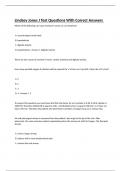Exam (elaborations)
Lindsey Jones J Test Questions With Correct Answers
- Course
- Institution
Which of the following can cause inverted T waves on a 12-lead ECG? A. second degree heart block B. hypokalemia C. digitalis toxicity D. hyperkalemia - Answer C. digitalis toxicity There are two causes of inverted T waves: cardiac ischemia and digitalis toxicity. How many portable o...
[Show more]



